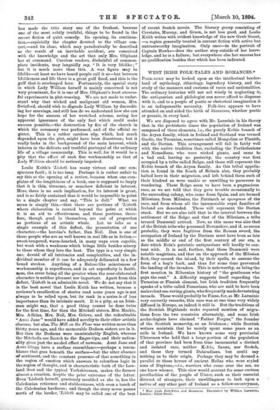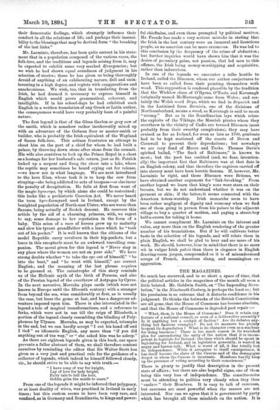WEST IRISH FOLK-TALES AND ROMANCES.* FOLK-LORE may be looked upon
as the intellectual border- land of mythology, ethnology, legendary history, and the study of the manners and customs of races and nationalities.
The ordinary historian will not act wisely in neglecting it, the antiquarian and philologist can never afford to dispense with it, and to a people of poetic or rhetorical imagination it is an indispensable necessity. Folk-lore appears to have attended on and aided the birth of literature, whether poetic or prosaic, in every land.
We are disposed to agree with Mr. Larminie in his theory that in the prehistoric times the population of Ireland was composed of three elements, i.e., the purely Keltic branch of
the Aryan family, which in Ireland and Scotland was termed Gaelic, the Turanian, sometimes called Mongolian or Finnish, and the Iberian. This arrangement will fall in fairly well with the native tradition that, excluding the Partholimians and Nemedians, who were wicked giants, and came to a bad end, leaving no posterity, the country was first occupied by a tribe called Belgm, and these will represent the Keltic branch of the Aryan family. As this tribal appella- tion is found in the South of Britain also, they probably halted here in their migration, and left behind them such of their kindred as were unable or unwilling to persevere in wandering. These Belgm seem to have been a pugnacious race, as we are told that they gave trouble occasionally to the succeeding colony, who came from Spain, and are termed
Milesians, from Milesius, the Patriarch or eponymus of the
race, and from whom all the innumerable royal families of Ireland are descended. These will represent the Iberian stock. But we are also told that in the interval between the settlement of the Belgx and that of the Milesians, a tribe termed Damnonii arrived. Now, as this name was also that of the British tribe who possessed Devonshire, and if, as seems probable, they were fugitives from the Roman sword, the occupation of Ireland by the Iberians must have been as late as the middle or end of the first century of our era, a
date which Erin's patriotic antiquarians will hardly be con- tent with. It is said, further, that these Danmonii were
notable magicians, and that on the approach of the Milesian fleet, they caused the island, by their spells, to assume the form of a hog's back, and thus for some time prevented the landing of the invaders. This is noteworthy, as being the first mention in Hibernian history of "the gentleman who pays the rent." A difficulty suggests itself regarding the Turanian or Finnish element, but Irish tradition frequently speaks of a tribe called Fomorians, who are said to have been malevolent sea-roving giants, who frequently made devastating inroads. These would probably be Finns, for, as Mr. Larminie very correctly remarks, this race was at one time very widely diffused in Europe, as indeed it still is. But the traditions of the Scottish Highlands make repeated mention of migra- tions from the two countries alternately, and some Irish archaaologists have claimed "Father Fergas," the founder of the Scottish monarchy, as an Irishman ; while Scottish writers maintain that he merely spent some years as an exile in Ireland. We have known some very provincial Ulstermen who held that a large portion of the population of that province had been from time immemorial a distinct and isolated race, neither Keltic, Saxon, nor Scotch, and these they termed Dalaradians, but could say nothing as to their origin. Perhaps they may be deemed a parallel to those heroes of ancient Hellas who were styled sons of Neptune,—i.e., warriors who came over the sea, no one knew whence. This view would account for some curious peculiarities of the people of Ulster, such as their unsocial distrust of strangers, their unwillingness to look upon a native of any other part of Ireland as a fellow-countryman,
• West Irish Polk-Tales and Romances. Translated by William Larrainie. London: Elliot Stook.
their democratic feelings, which strangely influence their conduct in all the relations of life, and perhaps their insensi- bility to the blessings that may be derived from "the breaking of the last links."
Mr. Larminie, therefore, has been quite correct in his state- ment that in a population composed of the various races, the folk-lore, and the traditions and legends arising from it, may be expected to exhibit some very marked divergencies ; but we wish he had shown equal soundness of judgment in his selection of stories ; those he has given us being thoroughly devoid of anything of an exhilarating nature, dull and unin- teresting in a high degree, and replete with exaggerations and anachronisms. We wish, too, that in translating from the Irish, he had deemed it necessary to express himself in English which would prove grammatical, coherent, and intelligible. If in his school-days he had exhibited such English in a written translation of any Greek or Latin author, the consequences would have very probably been of a painful nature.
The first legend is that of the Gloss Gaylen or grey cow of the smith, which is somehow rather incoherently mixed up with an adventure of the Gobaun Seer or master-smith or builder, who is probably the Irish equivalent of the Wayland of Saxon folk-lore. This artisan frustrates an attempt to cheat him on the part of a chief for whom he had built a palace, by throwing down stone after stone from the summit. His wife also contrives to lock up the Prince Royal in a chest as a hostage for her husband's safe return, just as St. Patrick locked up a serpent and flung the chest into a lake, where the reptile may sometimes be heard crying out for release, —we know not in what language. We are next introduced to the hero Klan, whose task it is to keep the cow from straying—she being addicted to acts of trespass—or else incur the penalty of decapitation. He fails at first from want of the magic byre-rope, by which alone she could be restrained ;
this looks like a prehistoric Coercion Act. We never heard the term byre-farmyard used in Ireland, except by the benighted population of North-east Ulster, who are worse than Saxons, being actually of Scotch descent. He recovers this article by the aid of a charming princess, with, we regret to say, some damage to her reputation in the form of a baby. This scion of a race of heroes grew up to maturity and slew his tyrant grandfather with a lance which he "took out of his pocket." It is well known that the citizens of the model Republic carry revolvers in their hip-pockets, but a lance in this receptacle must be an awkward travelling com- panion. The moral given for this legend is "Never stay in any place where the women are not on your side." We have strong doubts whether "to take the eye out of himself," "be into the boat," and "he went with himself," are correct English ; and the meaning of the last phrase requires to be guessed at. The catastrophe of this story reminds us of the Hellenic myth of the birth of Perseus, and also of the Persian legend of the overthrow of Astyages by Cyrus. In the next narrative, Morraha plays cards (which were not known in Europe until the fifteenth century) with a stranger from beyond the sea, wins considerably at first, as is usually the case, but loses the game at last, and has a dangerous ad- venture imposed upon him. There is also intercalated in the legend a tale of magical transformations, and a reference to forks, which were not in use till the reign of Elizabeth, a portion of the legend closely resembling the blinding of Poly- phemus by Ulysses. Morraha, as may be expected, triumphs in the end, but we can hardly accept "I cut his hand off and
I tied" as idiomatic English, any more than "if you did anything out of the way," or " she asked him was he asleep." As there are eighteen legends given in this book, our space prevents a fuller abstract of them, we shall therefore content
ourselves by reminding the editor that Sir Walter Scott has given us a very just and practical rule for the guidance of a collector of legends, which indeed he himself followed closely, viz., he should strive to be able to say with truth :—
" I have song of war for knight, Lay of love for lady bright, Fairy tale to lull the heir, Goblin grim the maids to scare."
From one of the legends it might be inferred that polygamy, or at least duality of wives, was practised in Ireland in early times ; but this custom seems to have been very rare, and confined, as in Germany and Scandinavia, to kings and power-
ful chieftains, and even these prompted by political motives. Mr. Fronde has made a very serious mistake in stating that the Irish in the last century were an immoral and licentious people, as no assertion can be more erroneous. He was led to this conclusion by the frequency of the crime of abduction ; but further inquiries would have shown him that it was the desire of pecuniary gains, not passion, that led men to this offence, the Irish being money-worshipping and acquisitive, rather than industrious.
In one of the legends we encounter a tribe hostile to Ireland, called the Bluemen, whom our author conjectures to have been so called from their painting themselves with woad. This supposition is rendered plausible by the tradition that the Wicklow clans of O'Byrne, O'Toole, and Kavanagh (originally named McMurraugh) came from Wales ; and cer- tainly the Welsh word Bryn, which we find in Bryneich and in the Latinised form Bernicia, one of the divisions of Northumberland, means a wood, as Kavanagh is said to mean "strong." But as in the Scandinavian lays which relate the exploits of the Vikings, the Moorish pirates whom they overthrew in the vicinity of Cadiz are termed Bluemen (most probably from their swarthy complexions), they may have cruised as far as Ireland, for even as late as 1700, gunboats had to be kept stationed off the coasts of Devon and Cornwall to prevent their depredations ; but nowadays we are very fond of Moors and Turks. Thomas Davis's spirited ballad, "The Sack of Baltimore," is known to most ; but the poet has omitted (and, we fear, intention- ally) the important fact that Baltimore was at that date in an English colony, and that therefore the captives carried of into slavery must have been heretic Saxons. If, however, Mr. Larminie be right, and these Bluemen were Britons, we have obtained another argument for "link-breaking." From another legend we learn that king's sons wore stars on their breasts, but we do not understand whether it was on the garment or akin; if the latter it seems connected with the American totem-worship. Irish monarchs seem to have- been rather negligent of dignity and economy when we find one of them going in person from his palace to the adjacent village to buy a quarter of mutton, and paying a street-boy half-a-crown for taking it home.
We cannot compliment Mr. Larminie on the interest and value, any more than on the English rendering of the greater number of his translations. But if he will cultivate better taste in the selection of his legends, and will relate them in plain English, we shall be glad to hear and see more of his work. He should, however, bear in mind that there is no more wit in vulgar Irish patois than there is elegance in English drawing-room jargon, compounded as it is of misunderstood scraps of French, American slang, and meaningless ex- aggeration.







































 Previous page
Previous page